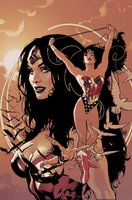Profile: Lois Lane
 Lois Lane
Lois LaneFirst appearance: Action Comics #1 in June 1938. Note that this entry could refer to all incarnations of her, including as a resident of Earths One and Two, and today.
Current status: now married to the Man of Steel, and ever the crusading-for-justice journalist she’s always been.
Was subjected to the following acts of discrimination: Lois has been through many situations that do raise questions and certainly are telling of the times in which she’s lived. In the Golden Age, she’d actually had to make do with put-downs from her boss, Perry White, among others who argued that certain jobs were more fit for a man than for a woman, and which may have included Superman himself (when Roy Thomas wrote All-Star Squadron in the 80s, he didn’t make things all that different. At least, not in how I saw him doing it in the 1984 annual). During the Silver Age, we had absurd slapstick situations such as those seen in Superman’s Girlfriend Lois Lane, in which she got turned into “The Fattest Woman in Metropolis!” or even was depicted as a startling vixen. That series, in fact, did have a problem at times of depicting women as pea-brained, venomous, petty obsessed and were desperate for a mate with whom to fulfill their lives. Lois herself was shrewish, petty and a schemer in her own series, which is quite alarming when you’d think that she, of all people, would surely have been touted as the most likely candidate for being someone whom working women could admire in a fictional story. It was only after the series ended in the Bronze Age that things started to improve for her characterization. Of course, we should also note that in the Iron Age, she got stuck in the “Byrne Hold” at the hands of Metallo, all for the sake of it, and, more recently, there was also her plot device-ish depiction in Identity Crisis, with her being depicted more as an entity whose feelings were clearly not important, and who only served as a vehicle of importance to the male characters in the book. In a storyline written by Greg Rucka in Superman, she was also shot and injured while on the job.
What’s wrong with how this was done? In the Golden and Silver Ages, let’s just say that, if only people had been more wide-minded than they were at the time! Wouldn’t that have been wonderful? In the case of the Byrne Hold, excess is the word for how she ended up being picked up by the neck. And, in the case of IC, it was total contempt for her character and her potential.
The really odd thing about the Super-Family during the Silver Age, if any, was that they were probably the least realistically depicted group of characters at the time. Most other couples in comics at the time, certainly under the pens of Gardner Fox and Bob Haney, usually led much more plausible relations as far as these things go in comic book worlds with sci-fi, fantasy and surrealism involved. Clark Kent’s and Lois Lane’s, by contrast, may have been all but the most neglected under those terms, until the Bronze Age, and certainly until the Iron Age, when succeeding writers began to depict them in more grownup fashion, and didn’t go too far with the slapstick effects.





